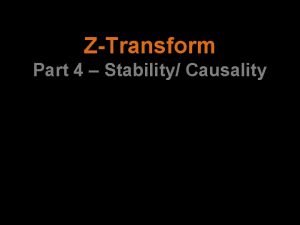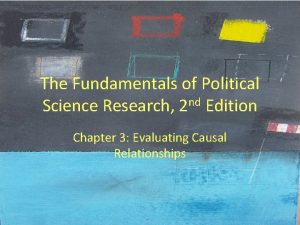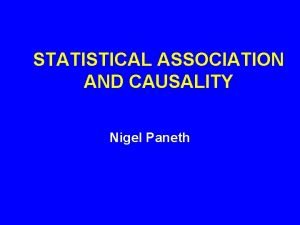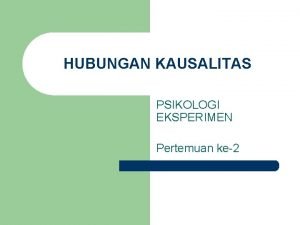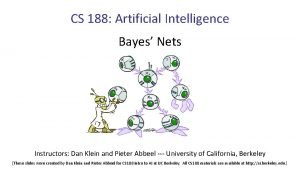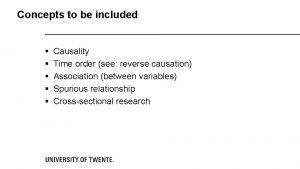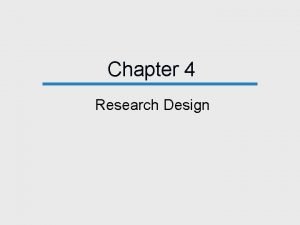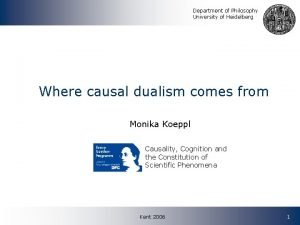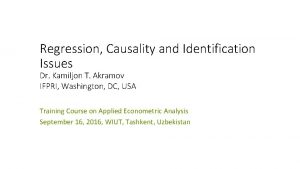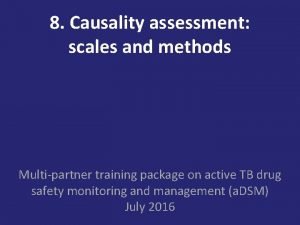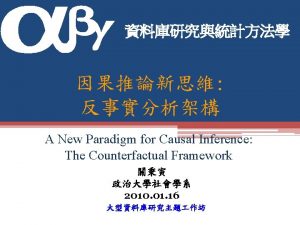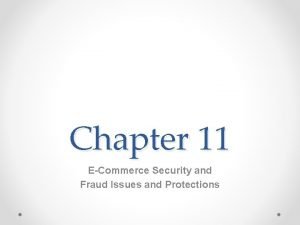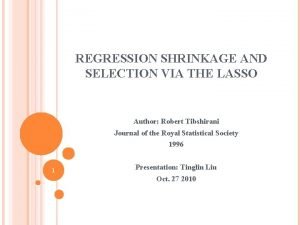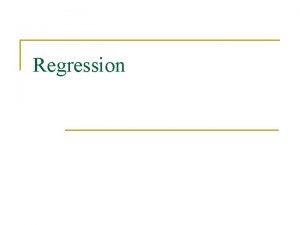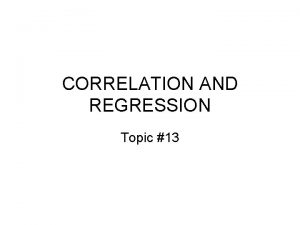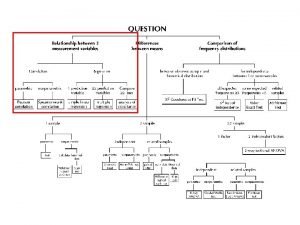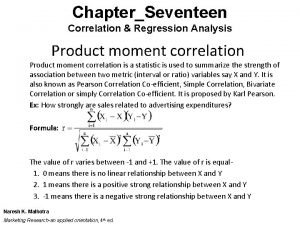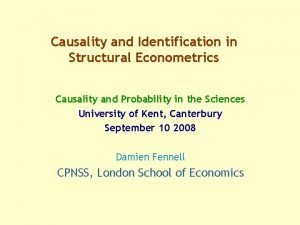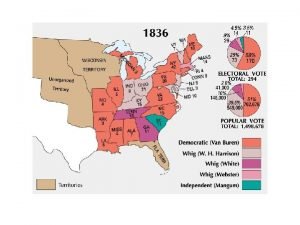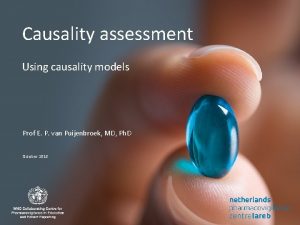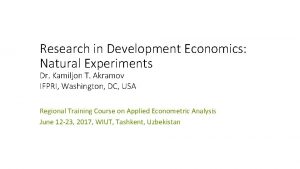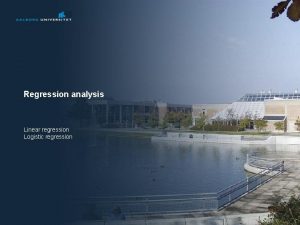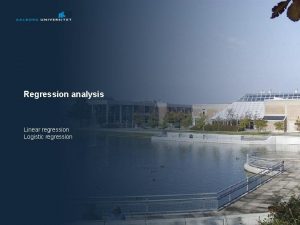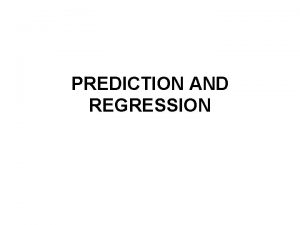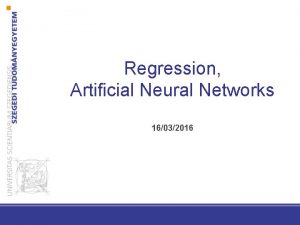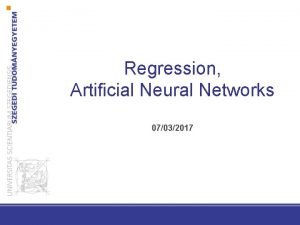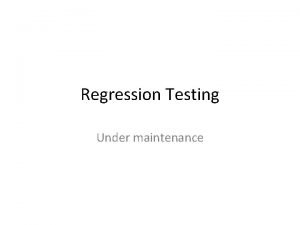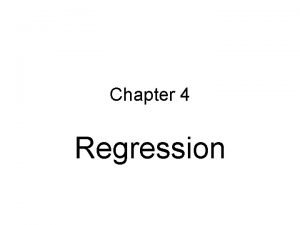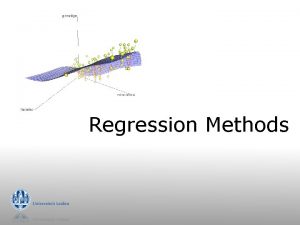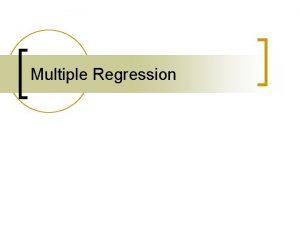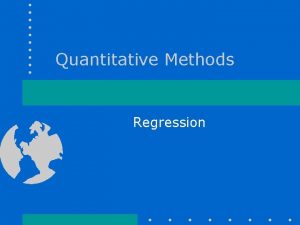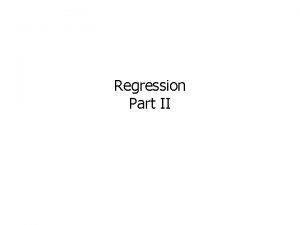Regression Causality and Identification Issues Dr Kamiljon T




























- Slides: 28

Regression, Causality and Identification Issues Dr. Kamiljon T. Akramov IFPRI, Washington, DC, USA Training Course on Applied Econometric Analysis September 16, 2016, WIUT, Tashkent, Uzbekistan

Motivation • While purely descriptive research is important and valuable, the excitement in economics comes from the opportunity to examine causal relationships in human affairs • Questions • What is the causal relationship of interest? • What is your identification strategy? • What is your mode of statistical inference? • The most challenging empirical questions in economics involve causal-effect relationships • What is the causal effect of schooling on wages? • The causal effect of schooling on wages is the increment to wages an individual would receive if he or she got more schooling • The causal effect of a college degree is about 40% higher wages on average (Angrist and Pischke 2009) • The causal effect of institutions on economic growth (Acemoglu, Johnson, and Robinson 2001) • The causal effect of ODA on economic growth (Akramov 2012)

Motivation (Cont. ) • “Essentially, all (statistical) models are wrong, but some are useful” George E. P. Box (1987) • All regression (statistical) models are description of real world phenomenon using mathematical concepts, i. e. , they are just simplifications of reality • Regression analysis can be very useful if it is carefully designed • In accordance with current good practice guidelines, and • A thorough understanding of the limitations of the methods used • If not, it can be not only inaccurate but also potentially damaging by misleading policymakers, practitioners and public • Example: Relationship between levels of government debt and rates of economic growth (Reinhart & Rogoff controversy)

Standard OLS Model: Summary •

Assumptions of Classical Linear Regression Models •

Best Linear Unbiased Estimator (BLUE) • The Gauss-Markov theorem states that OLS estimator is BLUE if the assumptions 1 through 4 listed above are fulfilled • Unbiased means that the OLS estimates of the coefficients are centered around the true population values of the parameters estimated • Consistent means that as the sample size approaches infinity, the estimates converge to the true population parameters • Violations of one or more classical assumptions will produce biased and/or inconsistent parameter estimates

Causal analysis: schooling and earnings • Causal relationship between schooling and earnings tells us what people would earn, on average, if we could either • Change their schooling in a perfectly controlling environment or • Change their schooling randomly so that those with different levels of schooling would otherwise comparable • Conditional independence assumption (CIA) requires that we must hold a variety of control variables fixed for causal inferences to be valid • Selection on observables • Covariates to be fixed are assumed to be known and observed

Causal analysis: schooling and earnings •

Causal analysis: schooling and earnings • Comparison of average earning conditional on schooling status is formally linked to the average causal effect • If selection bias is positive, the naïve comparison of earnings exaggerates the benefits of schooling • CIA asserts that conditional on observed characteristics selection bias disappears and comparisons of average earnings across schooling levels have a causal interpretation

Fundamental problem of causal inference • It is impossible to observe the value of Y 1 i and Y 0 i on the same individual and, therefore, it is impossible to directly observe the effect of schooling on earnings • Another way to express this problem is to say that we cannot infer the effect of schooling because we do not have the counterfactual evidence, i. e. , what would have happened in the absence of schooling • Given that the causal effect for a single individual cannot be observed, we aim to identify the average causal effect for the entire population or for sub-populations

Fundamental problem of causal inference: solution • The econometric solution replaces the impossible-to-observe causal effect of treatment on a specific unit with the possible-to-estimate average causal effect of treatment over a population of units • Although E(Y 1 i) and E(Y 0 i) cannot both be calculated, they can be estimated. • Most econometrics methods attempt to construct from observational data consistent estimates of

Causal analysis: additional issues • In most circumstances, there is simply no information available on how those in the control group would have reacted if they had received the treatment instead • This is the basis for an important insight into another potential bias of standard regression analysis – treatment heterogeneity • Thus, two sources of biases need to be eliminated from estimates of causal effects from observational studies 1. Selection Bias: Baseline difference 2. Treatment Heterogeneity • Most of the methods available only deal with selection bias, simply assuming that the treatment effect is constant in the population or by redefining the parameter of interest in the population

Macro example • What explains income differences across countries? • Hypothesis: the quality of institutions explains the variation in per capita income across countries • How would you establish causal link between institutions and income? • Higher levels of economic development may cause higher levels of institutional quality • Unobserved variable may jointly determine both high levels of institutional quality and high levels of income

Threats to Classical Assumptions • Omitted variables • Model misspecification or wrong functional form • Measurement error • Selection bias • Simultaneous causality bias • All of these imply that E(ui|X 1, X 2) ≠ 0

Omitted Variable Bias • The bias in the OLS estimator that occurs as a result of an omitted factor is called omitted variable bias • For omitted variable bias to occur, the omitted factor “Z” must be: • a determinant of Y; and • correlated with the regressor X but unobserved, so cannot be included in the regression • Both conditions must hold for the omission of Z to result in omitted variable bias

Omitted Variable Bias Formula •

Potential Solutions to Omitted Variable Bias • If the variable can be measured, include it as a regressor in multiple regression • Possibly, use panel data in which each entity (individual) is observed more than once • If the variable cannot be measured, use instrumental variables regression • Run a randomized controlled experiment

OVB Example: estimates of the returns to education for men in the NLSY Controls (1) (2) (3) (4) (5) None Age dummies Col. (2) and additional control variables (mother’s and father’s years of schooling, and dummies for race and census region) Col. (3) and AFQT score Col. (4) and occupation dummies 0. 132 (0. 007) 0. 131 (0. 007) 0. 114 (0. 007) 0. 087 (0. 009) 0. 066 (0. 010) Table reports the coefficient on years of schooling in a regression of log wages on years of schooling and the indicated controls. Source: Angrist and Pischke (2009).

Misspecification or Wrong Functional Form • Arises if the functional form is incorrect • If an interaction term is incorrectly omitted, then inferences on causal effects will be biased • Variable transformations (logarithms) • Discrete dependent variables • For example, the effect of dietary diversity on nutritional outcomes may depend on children’s age • Other examples?

Measurement Error • In reality, economic data often have measurement error • Data entry errors in administrative data • Recollection errors in surveys • when did you start your current job? • Ambiguous questions problems • what was your income last year? • Intentionally false response problems with surveys • What is the current value of your financial assets? • How often do you drink and drive?

Measurement Error (cont. ) •

Sample selection bias • Standard OLS assumes that the data is collected through simple random sampling of the population • However in some cases, simple random sampling is thwarted because the sample, in effect, “selects itself” • Sample selection bias arises when a selection process • Influences the availability of data and • That process is related to the dependent variable • Correlation between the independent variable and other variables that are correlated with the outcome of interest render selection into the “Treatment group” non-random • Instead, assignment to the treatment group is a function of some other factor and, more importantly, that other factor may be correlated with an outcome

Selection Bias (example 1) • Institutional quality and economic development • There are both observed and unobserved processes that lead to the adoption and perpetuation of institutions across countries • These factors are correlated with economic development • Thus they need to be neutralized to avoid inducing a biased calculation of the treatment effects of institutions on growth • Otherwise, they will engender a difference in the baseline measures of the outcome of interest between the control and treatment group before exposure to the treatment • Thus, any difference in the control and treatment groups after exposure to treatment need to be adjusted to account for the preexisting differences

Selection Bias (example 2) • Returns to education: What is the return to an additional years of education? • Empirical strategy: • Sampling scheme: simple random sampling of workers • Data: earnings and years of education • Estimator: regress ln(earnings) on years of education • Ignore issues of omitted variable bias and measurement error – is there sample selection bias?

Potential Solutions to Sample Selection Bias • Institutions and economic development • IV (Acemoglu and Robinson, etc. ) • Returns to education • Sample college graduates, not workers including unemployed • RCTs • Construct a model of the sample selection problem and estimate that model

Simultaneous Causality • X causes Y, but what if Y causes X, too • Example: Class size effect • Initial hypothesis: Low STR results in better test scores assuming that there is a causal relationship running from STR to Test Scores through a better learning environment • But what if the school board responds to low average test scores by hiring more teachers for those school districts? • Then the causality runs both ways. But why is this a problem? • It leads to correlation between STR and the error term • Estimation of demand supply functions

Potential Solutions to Simultaneous Causality Bias • Randomized controlled experiment • Develop and estimate a complete model of both directions of causality: Large macro models (e. g. Federal Reserve Bank-US) • IV approach

Summary • Framework for evaluating regression studies: • Internal validity • External validity • Threats to internal validity of causal analysis: • • • Omitted variable bias Misspecification or wrong functional form Measurement error or errors-in-variables bias Sample selection bias Simultaneous causality bias • Next few days of the course will focus on modern tools of applied econometrics that help to detect causal relationships
 Simple linear regression and multiple regression
Simple linear regression and multiple regression Causality and stability in z-transform
Causality and stability in z-transform Teori jung psikologi kepribadian
Teori jung psikologi kepribadian Regression linear model
Regression linear model Survival analysis vs logistic regression
Survival analysis vs logistic regression Logistic regression vs linear regression
Logistic regression vs linear regression Central pocket vs plain whorl
Central pocket vs plain whorl Four causal hurdles
Four causal hurdles Association vs causality
Association vs causality Apa itu kuasalitas
Apa itu kuasalitas Reverse causality example
Reverse causality example Pixabay
Pixabay Purposes of research design
Purposes of research design Global introspection
Global introspection Example of recall bias
Example of recall bias Heidelberg university philosophy
Heidelberg university philosophy What are the potential solutions of
What are the potential solutions of Hubungan asosiasi dalam epidemiologi
Hubungan asosiasi dalam epidemiologi Causality assessment scales
Causality assessment scales Judea pearl causality
Judea pearl causality Legal ethical and societal issues
Legal ethical and societal issues Ecommerce security issues
Ecommerce security issues Law and ethics in information security
Law and ethics in information security Regression shrinkage and selection via the lasso
Regression shrinkage and selection via the lasso Pearson r correlation
Pearson r correlation Coefficient of regression
Coefficient of regression Pearson correlation coefficient
Pearson correlation coefficient Classification and regression trees (cart)
Classification and regression trees (cart) Difference between regression and correlation
Difference between regression and correlation

